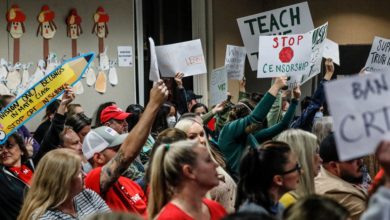Biden’s Plan for More Police Won’t Make America Safer

The “war on crime” is the highest-casualty, most expensive, and longest-lasting war in American history. This coordinated assault on the nation’s poorest communities has led to tens of millions of individuals locked up in cages with deadly long-term health consequences, at least 31,000 people killed directly by police, and trillions of dollars spent on pointless punishment. Despite being one of the safest countries, the United States has been one of the poorest in all the rich nations for more than 50 years. This is because the government continues to increase the public budget on prisons, police, and other security services.
It is not possible to separate this reality from the truth that U.S. safety policy was long misrepresented as an issue of only crime rate. This reductionistic narrative has been coupled with the manipulative message that if we feel unsafe, it is because we have not yet invested adequately in police, jails, and prisons—no matter how large their current budgets. But when safety is considered more comprehensively to include factors like homelessness and eviction, overdose risk, financial insecurity, preventable disease, police violence, and unsafe workplaces (which, statistically, present far greater preventable threats to everyday life than crime)—it is readily apparent America’s police-centric safety policies do not effectively promote shared safety.
Now, continuing the crime-war tradition and his own career-long advocacy for “tough on crime” policies, President Joe Biden is promoting his new “Safer America Plan.” This plan, announced in advance of upcoming midterm elections, appears calculated as a strategic response to widely publicized increases in crime—which have been grossly exaggerated by news media and opportunistic politicians—in marginalized communities still reeling from the social, medical, and economic devastation wrought by a mismanaged pandemic.
What does Biden’s plan propose? Consistent with his repeated calls to “fund the police” (as if false claims that police have been defunded after police murdered George Floyd were true), Biden is calling for hiring 100,000 more police officers and allocating at least an additional $13 billion to America’s police budgets—already by far the world’s largest. While the plan proposes funding for safety programs in non-police communities, it is very likely that these funds will be cut during legislative negotiations. Or worse, they could be directed through law enforcement authorities. By once again falsely equating police with safety, Biden is making clear that it is to the war on crime—not on poverty and the root causes of violence—that he remains devoted.
He’s not the only one. Many U.S. politicians from the local to federal level remain captive to widespread anxiety that they will become vulnerable to the fear-mongering attacks launched on any candidate who doesn’t bark loud enough in endless contests about who is “toughest” on crime. It is considered a problem to advocate for supportive care over policing or punishment. These impressions are well founded. A large number of voters have been persuaded by the collaboration between politicians, media and police that locking our neighbor’s doors is the best way to safeguard our family members.
The recall of the reformer Chesa Boudin as San Francisco District Attorney and the ascent of former policeman Eric Adams’ to Mayor of New York City are just the latest notable examples of the electoral payoffs of sticking to traditional American “law and order” tactics while ignoring their destructive consequences. Other Democrats, from Lori Lightfoot, Chicago, to London Breed, San Francisco, have adopted similar strategies, with surprisingly little distinction between Republican and Democratic criminal-legal agendas.
These short-sighted tactics have kept failed policy playing on repeat by reinforcing the false equation of policing and incarceration with “public safety.” Data make clear, however, that America’s policing and carceral systems neither effectively prevent crime nor protect collective safety. The safety of American communities has declined significantly over the past four decades, as a result of an increase in incarceration. Peer nations, however, have an average incarceration rate that is 85% higher than ours. Numerous studies have shown repeatedly that U.S. prisons go beyond the point where diminishing returns are possible, so that potential benefits far outweigh any risks. Decades of evidence reveal that incarceration not only doesn’t make us safer; it directly undermines public safety and, as the Covid-19 pandemic has underlined in bold, public health.
We need to completely rethink the concept of safety in light of these realities. To be fair, legislators must end supporting policies that marginalize the U.S. population for the short-term pleasure of the most powerful. For it to be effective, they need to wake up to the reality that no one will be truly safe until we focus public resources on repairing the harm that policing and mass incarceration have inflicted on America’s most dispossessed communities.
Rethinking Safety—Healthcare as Violence Prevention
A national context that has jails and prisons as a revolving doors through which tens or millions of people have flown in and out over the last 20 years, the psychological and economic harm that imprisonment causes to families, communities and the nation is felt throughout. This causes national instability, increases crime and devastates public health.
In reality, neither punishment nor police can substitute for good care. Safety is not about destructive punishment, but constructive investments in individuals and communities. It is time to invest in what works and start making American cities safer.
A large body of research has repeatedly demonstrated that a wide range of supportive public services—from emergency financial assistance and guaranteed basic income programs to summer jobs programs and neighborhood beautification—are very effective at preventing violence and protecting community safety. Recent studies have shown that access to healthcare is essential for maintaining shared safety.
A study published this year showed that 14% of men without Medicaid access are more likely to go to prison in the following two years. For people who have had psychiatric problems, this number rises to 21%. The second study showed that previous incarcerated persons have significantly lower rates of rearrest due to increased healthcare accessibility and Medicaid expansion. In addition, 16% less violent crime was seen in the first two years after release. And a third found that arrests significantly declined after the Affordable Care Act (ACA), with a 25–41% drop in drug arrests and 19–29% decrease in violence-related arrests in the three years following the ACA for counties that expanded Medicaid eligibility.
This should not be surprising for lawmakers as it is a continuation of three other studies that were published in 2020. The first two showed Medicaid expansion is associated with reductions in burglary, vehicle theft, homicide, robbery, and assault, resulting in significant cost savings—on the scale of many billions of dollars—that offset the public cost of ensuring a right to healthcare. A third study showed that Black children were incarcerated at a lower rate after 1990’s Medicaid expansion. This is primarily because of the reduction in financial-motivated crimes.
Access to treatment for addiction and mental health are important determinants in healthcare. A 2021 study showed that expanding mental health services in outpatient settings significantly reduces the crime rate and associated costs for communities. Two recent studies have shown that increasing access to treatment for substance abuse has the same effect as reducing crime.
Everybody will benefit from replacing Punishment by Care
If healthcare provides protection against violence, crime and incarceration then logic says that refusing to provide healthcare will only lead to violence, more crime and more incarceration. This is supported by the evidence. A recent study on health conditions of prisoners found that 50% were not covered by health insurance when they entered state prisons in 2016. In comparison, in the same period only 9% of U.S. citizens were uninsured.
America’s for-profit healthcare system is failing abysmally to provide basic care for U.S. residents. While this is well known, the fact that health policy mistakes are major drivers of U.S. safety problems, public distrust and high rates of gun violence remain largely ignored.
Lack of safety in American communities is inseparable from the reality that, for the last 25 years, the U.S. has remained the world’s only industrialized nation to refuse to provide universal healthcare as a fundamental public service to its citizens. Universal healthcare is essential to shared safety. Given the fact that crime and gun violence have been discussed more than any other political issue in recent months, it would make sense for lawmakers on both sides of Congress to focus their efforts towards ensuring that everyone has access to universal healthcare.
Unfortunately, U.S. legislators aren’t just Not expanding healthcare access; they’re now shrinking it while instead pouring ever-more money into already bloated police and prison budgets. Centers for Disease Control and Prevention estimate that more than 31million Americans were without any health insurance by the end of 2021. With the end of the federal government’s Covid-related emergency provisions, up to 15 million more people are now set to join the ranks of the uninsured. While the Inflation Reduction Act passed was sufficient to provide subsidies for 3.1 Million Americans to keep them from losing coverage by 2023, this is not enough to deal with the current healthcare exclusion.
History leaves little doubt that millions of those who are excluded from care by our lawmakers’ policy choices will, in the coming years, fall into crises that for some will lead to petty crimes, substance use and overdose, and acts of violence. And in this way, America’s racist cycles of violence, incarceration, and poverty will continue for as long as lawmakers remain committed to the delusion that police and prisons could ever produce safety in a nation that refuses to provide adequate care for its residents.
To stop these cycles and to begin to repair the harm they’ve left in their wake, U.S. lawmakers and their journalistic enablers need to reject the fear-mongering politics of crime and embrace in its place a politics and economy of care. We must all collectively redefine what shared safety means, how it is measured, who has to ensure it, and with which methods. This is how we will be able to achieve the shared safety goal by working together in dismantling perverse systems of retributive punishement and creating public programs of reparative support.
Read More From Time





